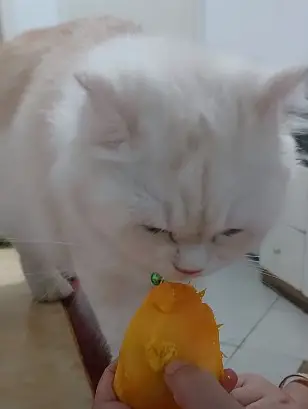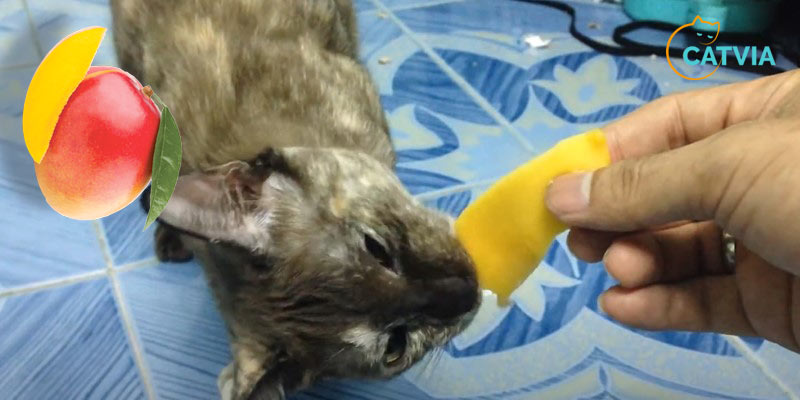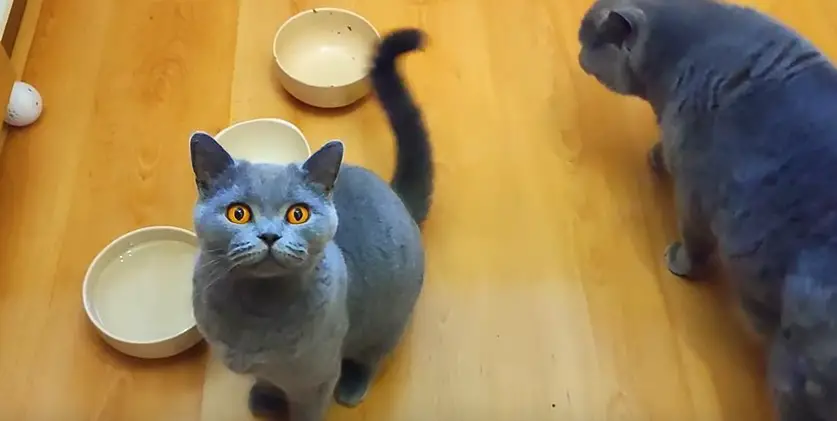Mango is safe for cats to eat, but it is not a necessary part of their diet. Mango is not toxic to cats, but it can cause an upset stomach.
If your cat eats too much mango, it may experience diarrhea or vomiting. If your cat has a mango-related stomach upset, it will likely recover on their own.
How to Feed Mango to Cats
If you decide to feed mango to your cat, you should do so in moderation. Start by giving your cat a small piece of mango to see how they react.

If they seem to enjoy it and have no adverse reaction, you can give them a little bit more.
Mango can be fed to cats fresh, canned, or dried. However, fresh mango is the healthiest option.
Canned mangoes often contain sugar or other sweeteners, which can be harmful to cats. Dried mangoes may also contain sugar or other sweeteners.
When feeding mango to your cat, make sure to remove the pit. The pit can be a choking hazard. Do not give your cat mango with the skin still on. The skin of a mango can be hard for cats to digest.
Is mango good for cats?
Cats are different from us when it comes to food. They need special food made for them with lots of animal protein. Mangoes are full of good stuff for people, like vitamin C. But cats can make their own vitamin C, so they don’t need mango.
Cats already get enough fiber from their cat food, so a bit of mango won’t change much. But if they eat too much fiber, it can upset their tummies. So, just a small piece of mango once in a while is usually okay for cats.
Mangoes are sweet, and too much sugar is not good for cats, especially if they’re overweight or have health problems like diabetes. For these cats, it’s better not to give them mangoes at all.
Does Mango provide any health benefits for cats?
Mangoes can provide some health benefits for cats when offered in moderation. Mangoes are rich in vitamin A, which is crucial for a cat’s vision, immune system, and overall health.
In small amounts, the dietary fiber in mango can support digestive health for some cats.
However, it’s important to emphasize that these potential benefits can be obtained through a balanced and complete cat food diet. Mango should only be offered as an occasional treat and should not replace their regular cat food.
Here’s a nutritional value chart for 1 cup (about 165 grams) of chopped mango:
| Nutrient | Amount per 1 Cup of Chopped Mango |
|---|---|
| Calories | 150 |
| Protein | 1.6 grams |
| Carbohydrates | 38 grams |
| Dietary Fiber | 3.7 grams |
| Sugars | 34 grams |
| Fat | 0.6 grams |
| Vitamin A | 1127 IU |
| Vitamin C | 60.1 mg |
| Vitamin E | 1.14 mg |
| Vitamin K | 6.9 mcg |
| Potassium | 257 mg |
| Magnesium | 18.5 mg |
| Phosphorus | 18.7 mg |
Can Cats Eat Dried Mango?
Mango is safe for cats to eat in small amounts, but dried mango is not recommended. Dried mango is much higher in sugar than fresh mango, and the sugar can cause digestive problems in cats.
Additionally, dried mango often contains preservatives and other chemicals that can be harmful to cats.
Preparing Mango for Cats
Removing the Pit and Skin: Before offering mango to your cat, it’s crucial to remove the pit, as it contains a small amount of cyanide, which is harmful. Also, peel the skin to eliminate potential choking hazards and reduce the risk of digestive discomfort.
Cutting Mango into Safe, Bite-Sized Pieces: After removing the pit and skin, cut the mango flesh into small, manageable pieces that your cat can easily eat. Smaller pieces reduce the risk of choking.
Considering Portion Sizes for Feline Consumption: Portion control is essential. Start with a very small amount, such as a teaspoon-sized portion, and monitor your cat’s reaction.
If your cat enjoys it and doesn’t experience any digestive issues, you can gradually increase the portion size. However, mango should only be an occasional treat, not a significant part of their diet.
Observe Your Cat: Watch your cat’s reaction closely. Some cats may show interest in the fruit and nibble on it, while others may not be interested at all. Pay attention to any signs of digestive upset or allergies.
Monitor for Digestive Issues: After your cat has had a small taste of mango, keep an eye on them for any signs of gastrointestinal distress, such as vomiting or diarrhea. If you notice any adverse reactions, avoid giving mango to your cat in the future.
Keep It Infrequent: Mango should only be given as an occasional treat, not a regular snack. Cats have specific dietary needs, and their primary food source should be a high-quality, balanced cat food designed to meet those needs.
Alternatives to Mango
- Safe Treats and Snacks for Cats: There are several safe and healthy treats designed specifically for cats available in pet stores. These treats are formulated to meet feline dietary needs.
- Homemade Cat Treats: Consider making homemade cat treats using cat-safe ingredients like lean meat or commercial cat treat recipes available online. This allows you to control the ingredients and ensure they’re tailored to your cat’s health.
- Commercial Cat Treats: Commercial cat treats are convenient, widely available, and formulated to meet your cat’s nutritional needs. They come in various flavors and textures to cater to your cat’s preferences.
Other safe fruits for felines
Safe fruits for cats can be occasional treats. Offer small, bite-sized pieces of fruits like watermelon, cantaloupe, or blueberries for added variety in their diet.
Here’s a list of some safe fruits for cats:
- Apples (remove seeds)
- Bananas
- Blueberries
- Cantaloupe
- Cranberries
- Mango (in moderation)
- Pears (remove seeds and core)
- Pineapple
- Raspberries
- Strawberries
- Watermelon
- Blackberries
- Peaches (remove pit)
- Apricots (remove pit)
- Kiwi (in moderation)
Can Cats Eat Mango Yogurt?
It is generally safe for cats to eat small amounts of mango yogurt as a treat. If you choose to give your cat mango yogurt, it is important to monitor them closely for any adverse reactions, such as vomiting or diarrhea.
“My cat has eaten too much mango” what should I do?
If your cat has eaten an excessive amount of mango, monitor them for signs of digestive upset, such as vomiting or diarrhea.
Ensure they have access to fresh water for hydration. Temporarily reduce their regular cat food intake to give their stomach a rest.
If severe or prolonged symptoms occur, consult your veterinarian for guidance and possible treatment. To prevent future issues, avoid offering mango to your cat in excess.
Conclusion
Remember that not all cats will enjoy or tolerate mango, and some may show no interest in it at all.
If your cat doesn’t seem to like mango or experiences any digestive issues, it’s perfectly fine to skip offering it altogether and focus on providing them with their regular cat food. That will ensure their nutritional requirements are met.
References:
- American Veterinary Medical Association (AVMA) – “Foods that are Hazardous to Cats.” Link
- The American Society for the Prevention of Cruelty to Animals (ASPCA) – “People Foods to Avoid Feeding Your Pets.” Link
- Pet Poison Helpline – “Toxic and Non-Toxic Plants & Foods for Pets.” Link
- “Mango Nutrition Facts and Health Benefits.” Healthline. Link
- “Feline Nutrition Basics.” American Association of Feline Practitioners. Link
Dr. John Morris, DVM is a Doctor of Veterinary Medicine who has seven years of experience in feline medicine, dermatology, and behavior. He also enjoys volunteering at a local NGO that supports literacy programs for children and adults. In his free time, he enjoys fostering kittens, traveling, vegan cooking, hiking, and biking. Learn more about Justin here.


